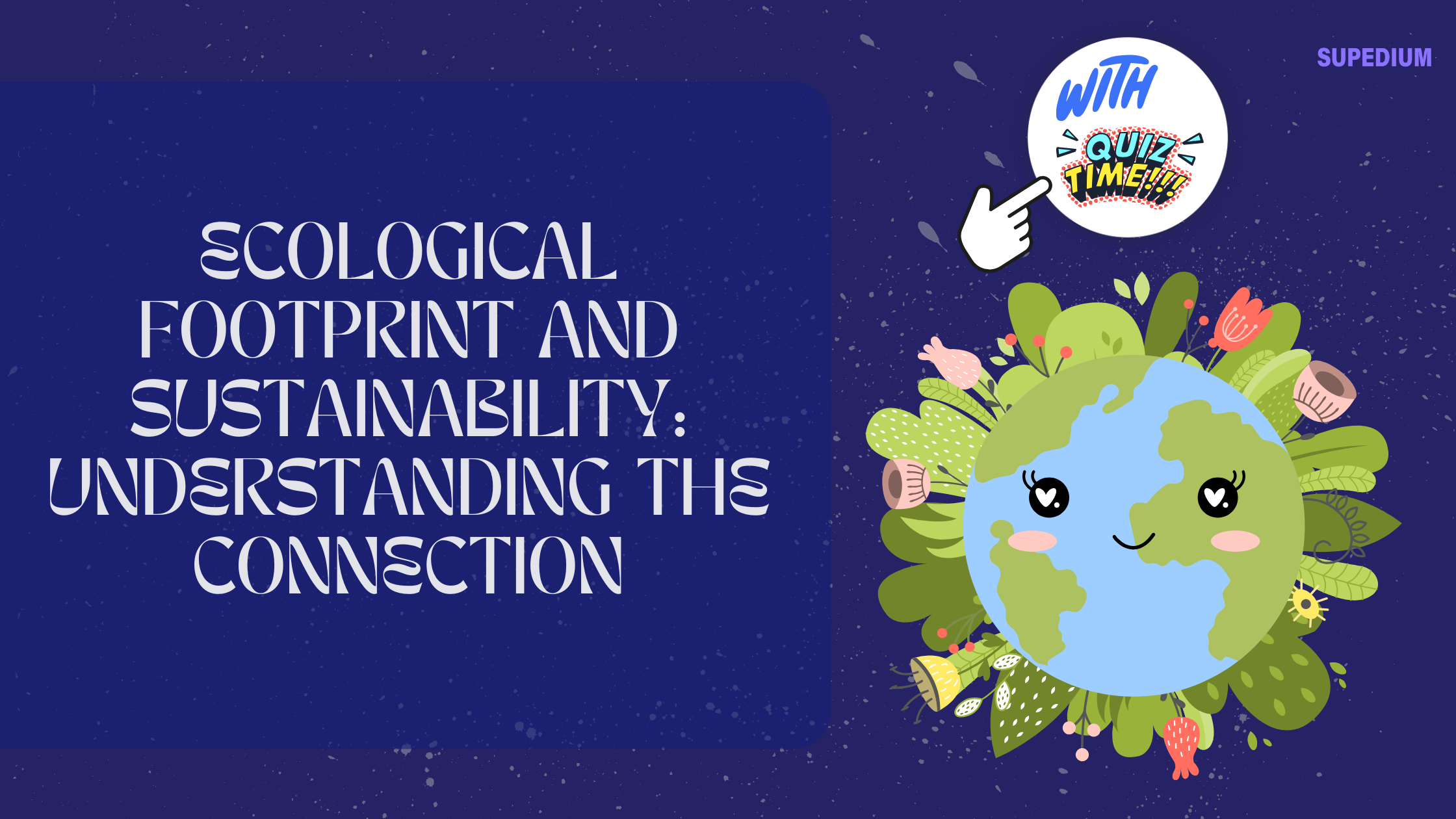Table of Contents
![]()
In an era of escalating environmental challenges, the concepts of ecological footprint and sustainability have gained increasing prominence. This article delves into these interconnected ideas, exploring their definitions, implications, and the critical role they play in shaping our future.
I. Introduction
Ecological Footprint refers to the measure of human impact on the environment. Originating from the work of Mathis Wackernagel and William Rees in the 1990s, this concept quantifies how much biologically productive land and water area is required to support human activities, including resource consumption and waste production. It is typically measured in global hectares or acres.
Sustainability, on the other hand, encompasses the capacity to maintain certain processes or states over time. Historically rooted in environmental movements of the 20th century, sustainability is commonly defined through three pillars: environmental protection, economic viability, and social equity. The intersection of ecological footprint and sustainability is crucial for understanding how current practices affect the planet and what changes are needed for future resilience.
II. Understanding Ecological Footprint
A. Components of Ecological Footprint
- Carbon Footprint: This component measures the greenhouse gas emissions resulting from human activities, particularly energy consumption and transportation. High carbon footprints contribute to climate change and global warming.
- Food Footprint: This represents the land required to produce the food consumed, including agricultural practices and dietary habits. Intensive farming and meat-heavy diets often lead to larger food footprints.
- Housing Footprint: Housing footprint accounts for the space and resources needed to construct and maintain buildings, including energy use and materials involved. Energy-efficient homes and sustainable construction practices can reduce this footprint.
- Goods and Services Footprint: This measures the impact of producing goods and providing services, including manufacturing processes and waste production. Reducing consumption and promoting recycling can mitigate this footprint.
B. Measuring Ecological Footprint
Various tools and methodologies are used to calculate ecological footprints, such as those provided by the Global Footprint Network. These calculations involve assessing resource use and waste generation to estimate the total ecological demand. Case studies illustrate the application of these methods, showing variations across different regions and lifestyles.
C. Global and Regional Variations
Ecological footprints vary significantly between developed and developing regions. Wealthier nations typically have larger footprints due to higher consumption rates, while developing regions often have smaller footprints but face challenges related to resource availability and environmental degradation.
III. Sustainability and Its Dimensions
A. Environmental Sustainability
Environmental sustainability focuses on managing natural resources responsibly to prevent depletion and preserve ecosystems. Key aspects include:
- Natural Resource Management: Efficient use of resources such as water, minerals, and forests to avoid overexploitation.
- Biodiversity and Ecosystem Health: Protecting diverse species and maintaining healthy ecosystems to ensure ecological balance.
- Pollution and Waste Management: Minimizing pollution and managing waste through recycling and sustainable practices.
B. Economic Sustainability
Economic sustainability involves practices that support long-term economic health without depleting resources. This includes:
- Sustainable Economic Practices: Encouraging industries to adopt eco-friendly methods and promote fair trade.
- Circular Economy Concepts: Shifting from a linear model of production and consumption to one that emphasizes reuse, recycling, and reduction of waste.
- Impact on Job Creation and Economic Stability: Sustainable practices can lead to new job opportunities and contribute to stable economies.
C. Social Sustainability
Social sustainability addresses human well-being and social equity:
- Equity and Social Inclusion: Ensuring equal access to resources and opportunities for all societal groups.
- Community Well-Being and Quality of Life: Promoting healthy and vibrant communities through social and environmental initiatives.
- Education and Awareness: Raising awareness about sustainability issues and encouraging responsible behavior.
IV. The Interplay Between Ecological Footprint and Sustainability
A. Impact of High Ecological Footprint on Sustainability
A large ecological footprint strains the planet’s resources, leading to:
- Resource Depletion: Overuse of resources can lead to shortages and environmental degradation.
- Environmental Degradation: Increased pollution and habitat destruction impact ecosystems and biodiversity.
- Social and Economic Consequences: Resource scarcity and environmental issues can lead to social conflicts and economic instability.
B. Strategies to Reduce Ecological Footprint
To mitigate the ecological footprint, various strategies can be employed:
- Energy Efficiency and Renewable Energy: Transitioning to renewable energy sources and improving energy efficiency in homes and industries.
- Sustainable Agriculture and Food Systems: Adopting practices that reduce the environmental impact of food production.
- Green Building Practices: Using sustainable materials and energy-efficient designs in construction.
- Reducing, Reusing, and Recycling: Minimizing waste and promoting circular economy principles.
C. Role of Policy and Governance
Effective policies and governance are essential for promoting sustainability:
- Environmental Regulations and Policies: Implementing laws and guidelines to protect natural resources and reduce pollution.
- International Agreements and Frameworks: Participating in global efforts such as the Paris Agreement to address climate change.
- Local and National Initiatives: Supporting local projects and policies that promote sustainability.
V. Case Studies and Examples
A. Countries or Regions with Successful Sustainability Practices
Several countries have made significant strides in sustainability:
- Examples of Low Ecological Footprint: Nations like Sweden and Denmark have implemented policies that reduce ecological footprints through renewable energy and sustainable practices.
- Innovative Sustainability Solutions: Cities such as Curitiba in Brazil and Copenhagen in Denmark are recognized for their innovative approaches to urban sustainability.
B. Comparative Analysis of High vs. Low Ecological Footprint Scenarios
Examining high versus low footprint scenarios highlights the importance of adopting sustainable practices. For instance, comparing the ecological footprints of high-consumption countries with those of lower-consumption nations can provide insights into effective strategies for reducing impact.
VI. Future Directions and Challenges
A. Emerging Trends in Sustainability
- Technological Advancements: Innovations such as green technology and smart grids are transforming sustainability efforts.
- Changing Consumer Behavior: Increasing awareness and demand for sustainable products influence market trends.
B. Challenges in Achieving Sustainability
- Political and Economic Barriers: Policy gaps and economic constraints can hinder progress toward sustainability.
- Cultural and Societal Resistance: Overcoming resistance to change and fostering a culture of sustainability is crucial.
C. Potential Solutions and Innovations
- Collaboration and Partnerships: Building alliances between governments, businesses, and communities can drive sustainability initiatives.
- Role of Education and Awareness: Educating individuals about sustainability and encouraging responsible behavior is vital for long-term success.
VII. Conclusion
In summary, the concepts of ecological footprint and sustainability are deeply interconnected. Reducing our ecological footprint is essential for achieving sustainability and ensuring the well-being of future generations. By adopting sustainable practices, supporting effective policies, and fostering global cooperation, we can work towards a more balanced and resilient planet.






Be the first to comment